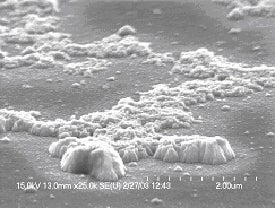CANi: Structure and Function |
||||||||||||
|
|

Considering the talents and experience of the diverse group of researchers already involved in nanoionic devices, we foresee a broad spectrum of activities from synthesis and materials characterization, to device and system design and analysis. There is considerable emphasis on trans-disciplinary activity as center affiliates, both within ASU and beyond, are encouraged to participate not only because of their interest in the underlying science and technology of the nanoionic field but also for their connections to diverse areas of application. CANi will ultimately have a synergistic coupling to the other centers within the Arizona Institute for Nanoelectronics. The low voltage and low current operation of nanoionic devices make the technology ideal for interfacing with nanoelectronic systems, and the optical, MEMS, and microfluidic applications fit well with AINE’s other areas of interest, including nano-optics and bio-electronics. Many of the ASU researchers with ties to nanoionics not only link CANi to diverse disciplines but also to other research centers on campus, such as WINTech, the Flexible Display Center (FDC), and the BioDesign Institute. The bulk of the physical work at ASU will leverage existing facilities on the Tempe Campus, including those within the Center for Solid State Electronics Research (CSSER) and the LeRoy Erying Center for Solid State Sciences (LE-CSSS), as well as new facilities within the MacroTechnology Works (MTW). However, CANi will be a non-traditional research unit as it will exist beyond the walls of ASU to embrace national and international membership. We will leverage the involvement of other research facilities to create a virtual nanoionics fabrication network, much like the DARPA-funded MEMS Exchange (MX). The outreach to prestigious institutions and top-tier companies will not only add to the Center’s experimental and theoretical research capability but the association will also help to establish the center as a key player in the field. In this respect, CANi will act as a “clearing house” for nanionic information from both academic and industrial sources. To this end, we will hold an annual symposium in the field as well as publish a variety of reports (produced by the Center’s undergraduate and graduate student affiliates) that digest and highlight nanoionic activities not only at ASU but also in other groups. Since there will be a heavy emphasis on “use inspired research”, CANi is also partnering with Arizona Technology Enterprises (AzTE) and its Technology Ventures Clinic (TVC), and the on-campus entrepreneurship organizations to ensure that the membership, including students, will be trained in intellectual property and commercialization issues. As part of the outreach activity, the Center will provide a basic “nanoionics toolkit” for experimentation for groups ranging from high school students to industrial laboratories. In our experience, many other researchers would very much like to work nanoionic materials into new applications but lack the capability to form even basic films and structures. Therefore, in order to seed a wider range of activity and applications, we will provide basic fabrication services as well as a range of nanoionic “components” along with consulting support. | |||||||||||
|
||||||||||||
